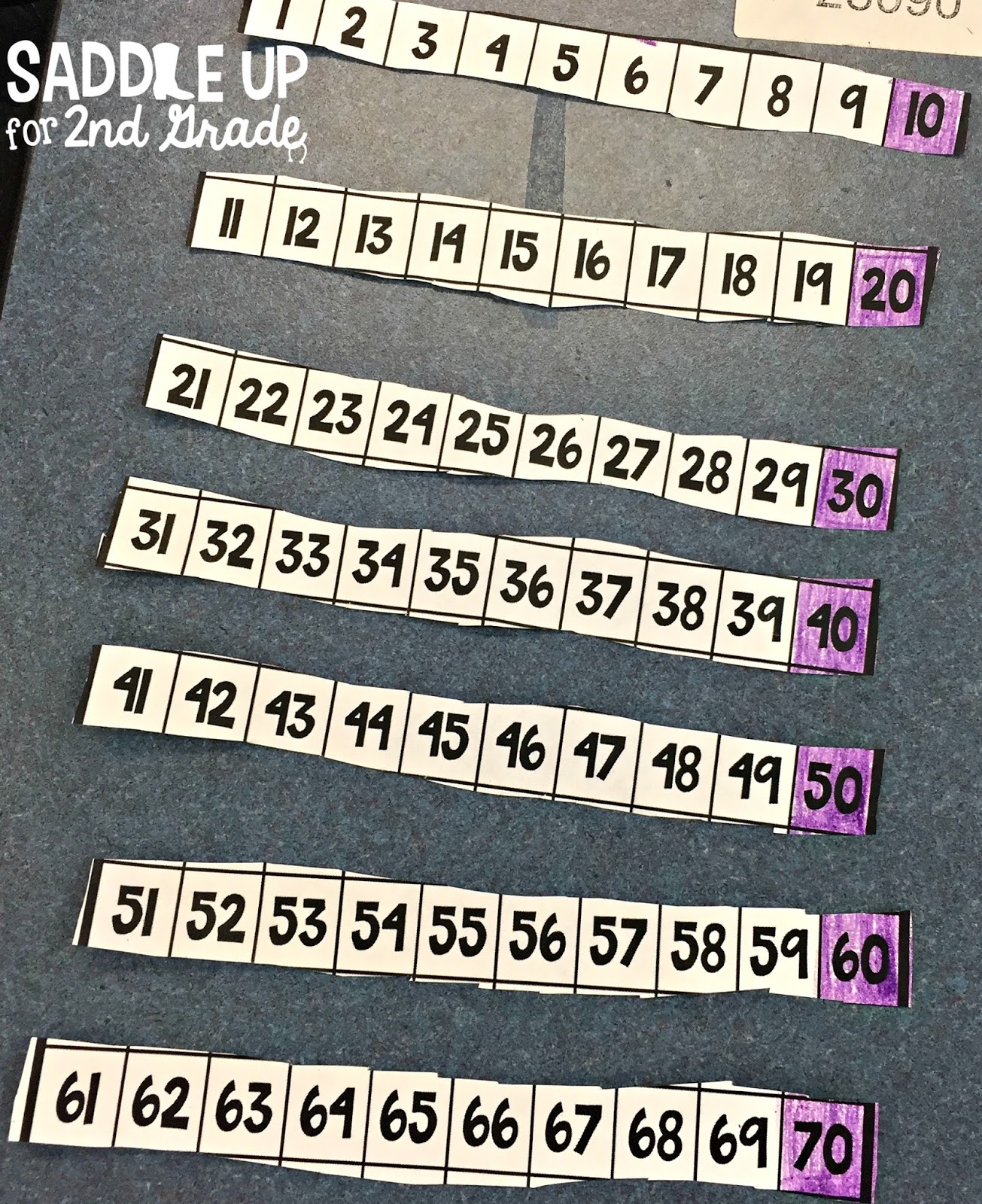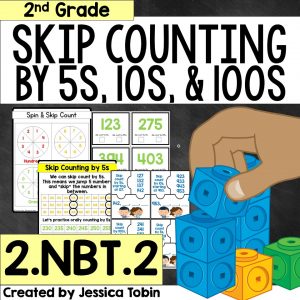
In this blog post, you will find a variety of skip counting activities to help your students learn how to count within 1,000 in various ways. It is essential for 2nd grade students to master skip counting. This skill will help them understand place value, which is applied to addition and subtraction problems in 2nd grade and multiplication and division problems in 3rd grade. Along with being key for further math instruction, skip counting is an essential life skill as well.
2nd Grade 2.NBT.2: Count within 1000; skip-count by 5s, 10s, and 100s.
This standard isn’t introduced until 2nd grade. However, skip counting by 5’s, 10’s, and 100’s can be introduced in Kindergarten and 1st grade during calendar time. Students can practice this skill with various skip counting activities as well as in short periods of time, such as while waiting in line, transitioning to the next activity, etc.
I hope you enjoy this blog post and find the activities helpful. Feel free to share this with your Kindergarten and 1st grade teacher friends. Read on and keep an eye out for a freebie skip counting by 5’s activity towards the end of this blog post.
Discuss Differences Between Counting and Skip Counting

When kicking off a new math unit, beginning with discussion and anchor charts is good practice. These anchor charts are included in my skip counting activities unit. First, students need to understand the differences between counting and skip counting. Counting by 1’s focuses on the ones place value. Students learn that they may count by 1’s starting at any number. On the other hand, skip counting focuses on the tens, hundreds, and thousands place values.
Students learn that they can count quickly by skipping over numbers when they skip count. They will identify patterns, especially when using a number chart. With their knowledge of place value, students will eventually be able to skip count beginning at any number. Finally, students will become competent in doing this without a number chart.
Make It Concrete

(Source: RoyalBaloo)
When it comes to skip counting, hands-on activities are a must. This skip counting with Legos activity is a great visual for students to see how skip counting works. In addition, it helps them realize how much faster it is. The two notches on the Legos help students grasp this concept more quickly, especially when lined up underneath the single Legos. The notches also help our tactical students as they can feel the notches and count by 2’s effectively. Adding the number tiles brings the whole concept together. This can be done when skip counting by different numbers.
While skip counting by 2’s is not part of the common core math standards, it is still a key skill to teach students. Counting by 2’s is a life skill and will help them down the road when it comes to multiplication.

(Source: SimplyKinder)
The next hands-on skip counting activity is a fun, simple game. This can be done with skip counting by 5’s or any other number. Students can play in multiple ways. The first game is a simple puzzle where students spread out the craft sticks and order them by the number they are skip counting by. The second game is played by having students draw a stick and skip count to 100 beginning at that number. This can be challenging for beginning learners, but will help them develop this skill.

(Source: Saddle Up for Second Grade)
Skip counting chains are another hands-on skip counting activity. Students help create an anchor chart for counting by whatever number you are working on. Then, they color in a number chart as you orally count out loud together. After that, students cut their number chart into strips as shown and turn their strips into skip counting chains. The anchor chart can be adapted to match the number you are skip counting by. For example, for skip counting by 10’s, students colored 10 toes. 10 toes represents counting by 10’s. For skip counting by 5’s, students colored a hand. For skip counting by 2’s, they colored eyes. The more realistic your examples, the more concrete the activity is for them.

This skip counting puzzle activity is offered in the skip counting unit bundle. This activity is on target for the “green group” remedial activity offered during teacher time. The visual aid helps the students put the numbers in order, thus helping them learn to skip count more effectively.
Start with Skip Counting by 5s

When you begin to teach skip counting, it is best to start with skip counting by 5’s. This is a smaller jump and will help them build up to skip counting by larger numbers. The students will start to understand the patterns in the number chart and that two 5’s make a 10. This will help them when they move on to count by 10’s.
It is essential that you teach students to skip count starting at any given number, not just multiples of 5’s and 10’s. Once they have mastered the basics of skip counting by 5’s with multiples of five, challenge them to start at other numbers and identify those patterns.
Move to Skip Counting by 10s and 100s

After teaching students to skip count by 5’s, move on to teach skip counting by 10’s and 100’s. By helping students understand place value, they will learn to skip count by 10’s and 100’s at the same time. For example, they will see that it is essentially the same, they just add a zero to the ones place when counting by 100’s.
Tie In Technology

(Link: IXL Game)
Incorporating technology in your skip counting activities is an effective way to keep students engaged and offer more practice with this skill. IXL has a free skip counting game that can be used to help your students practice skip counting by 2’s, 5’s, and 10’s. The models offer a concrete visual for the students as they work through the problems. IXL can be used to re-teach, supplement, and extend math skills.
Incorporate Into Daily Calendar Time

(Source: This Reading Mama)
One of the easiest ways to practice skip counting is by incorporating it into your daily calendar time. This rote counting (or skip counting) wall can be hung near your calendar for daily practice. Furthermore, allowing students to lead the class using pointers makes this a fun skip counting activity.
Practice Makes Perfect

This skip counting unit includes many differentiated skip counting activities. There are partner games, such as these skip counting task cards. Students can work together to coach each other through skip counting beginning at any number. Independent activities, such as spin and skip count and activities that encourage students to determine what number they are skip counting by strengthen knowledge as well. Students also have the opportunity to explain their thinking with math writing activities.

By offering many skip counting activities to practice, students will master this skill and be able to apply it to math instruction in the future as well as real life daily activities. Every student learns differently, which makes this unit work well for the whole class, as all types of learners will benefit.
Resources You May Like…

Click the buttons to grab the link you need.
Want to try a FREE lesson plan? I’ve pulled the 2nd lesson plan collection out of this resource for you to try out. Sign up for FREE here.
Thanks for reading this blog post all about skip counting. If you are looking for more blog posts for math, check these out…


















